Operations Management Report: Pharmaceutical Industry Analysis
VerifiedAdded on 2020/03/23
|16
|4100
|36
Report
AI Summary
This report delves into the realm of operations management within the pharmaceutical industry, offering a comprehensive analysis of its evolving landscape. The report explores the impact of globalization, technological advancements, and changing customer expectations on pharmaceutical companies. It highlights the importance of resource management, supply chain optimization, and forecasting and planning in achieving operational efficiency and competitive advantage. The report also examines the significance of quality assurance systems and the challenges and opportunities presented by emerging markets. Furthermore, the report discusses the strategies pharmaceutical companies can adopt to navigate these complexities and ensure sustainable growth, emphasizing the need for adapting to new technologies and meeting global regulatory standards while maintaining a customer-centric approach.
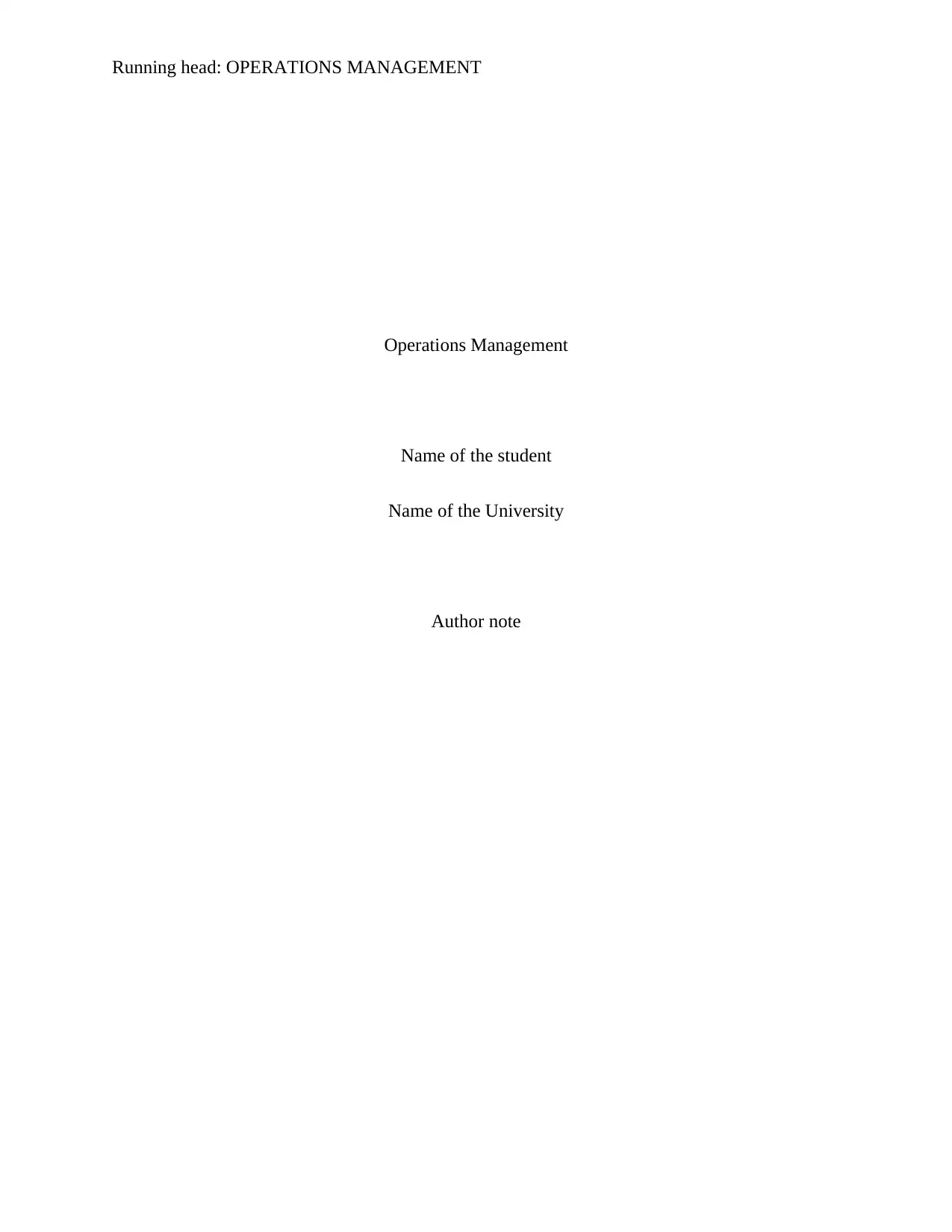
Running head: OPERATIONS MANAGEMENT
Operations Management
Name of the student
Name of the University
Author note
Operations Management
Name of the student
Name of the University
Author note
Paraphrase This Document
Need a fresh take? Get an instant paraphrase of this document with our AI Paraphraser
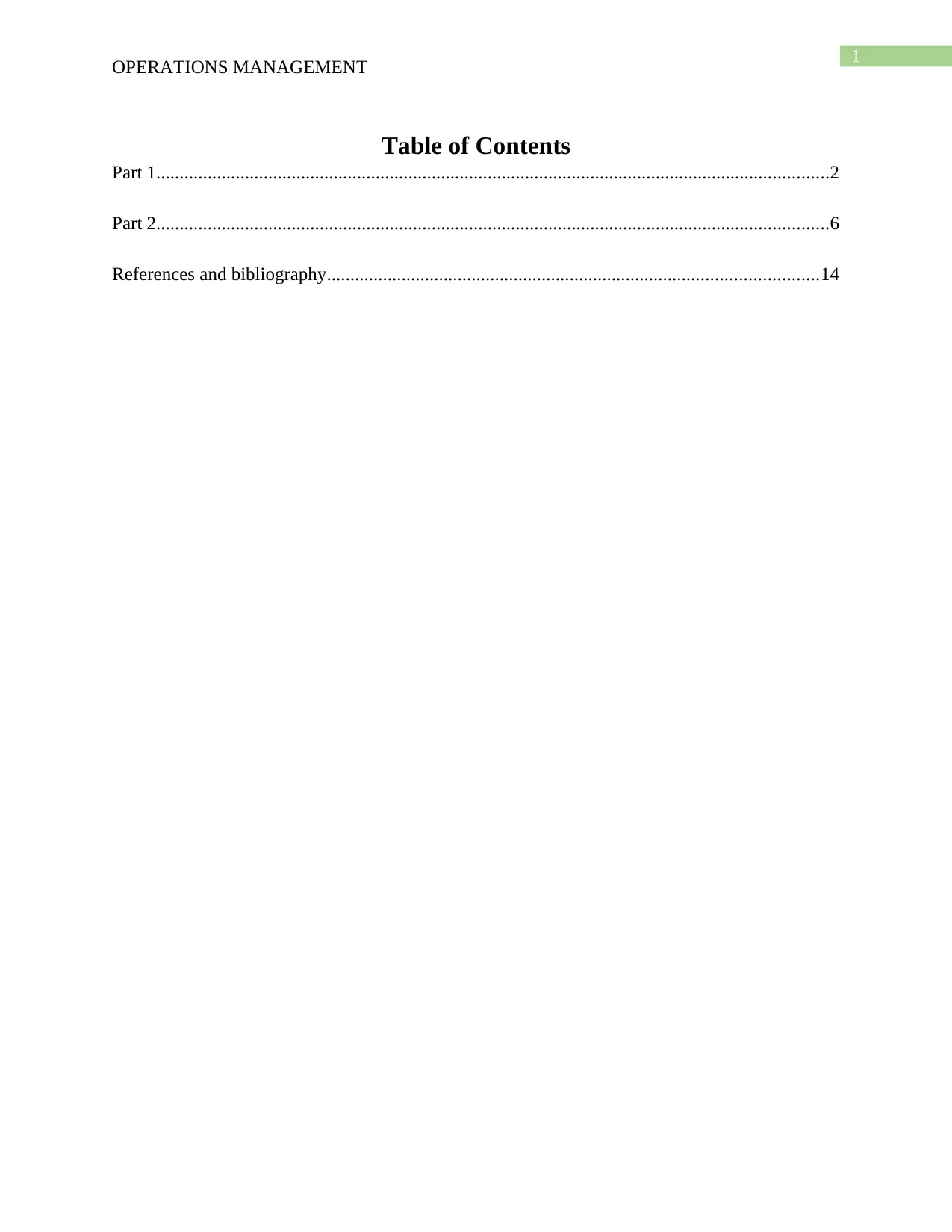
1
OPERATIONS MANAGEMENT
Table of Contents
Part 1................................................................................................................................................2
Part 2................................................................................................................................................6
References and bibliography.........................................................................................................14
OPERATIONS MANAGEMENT
Table of Contents
Part 1................................................................................................................................................2
Part 2................................................................................................................................................6
References and bibliography.........................................................................................................14
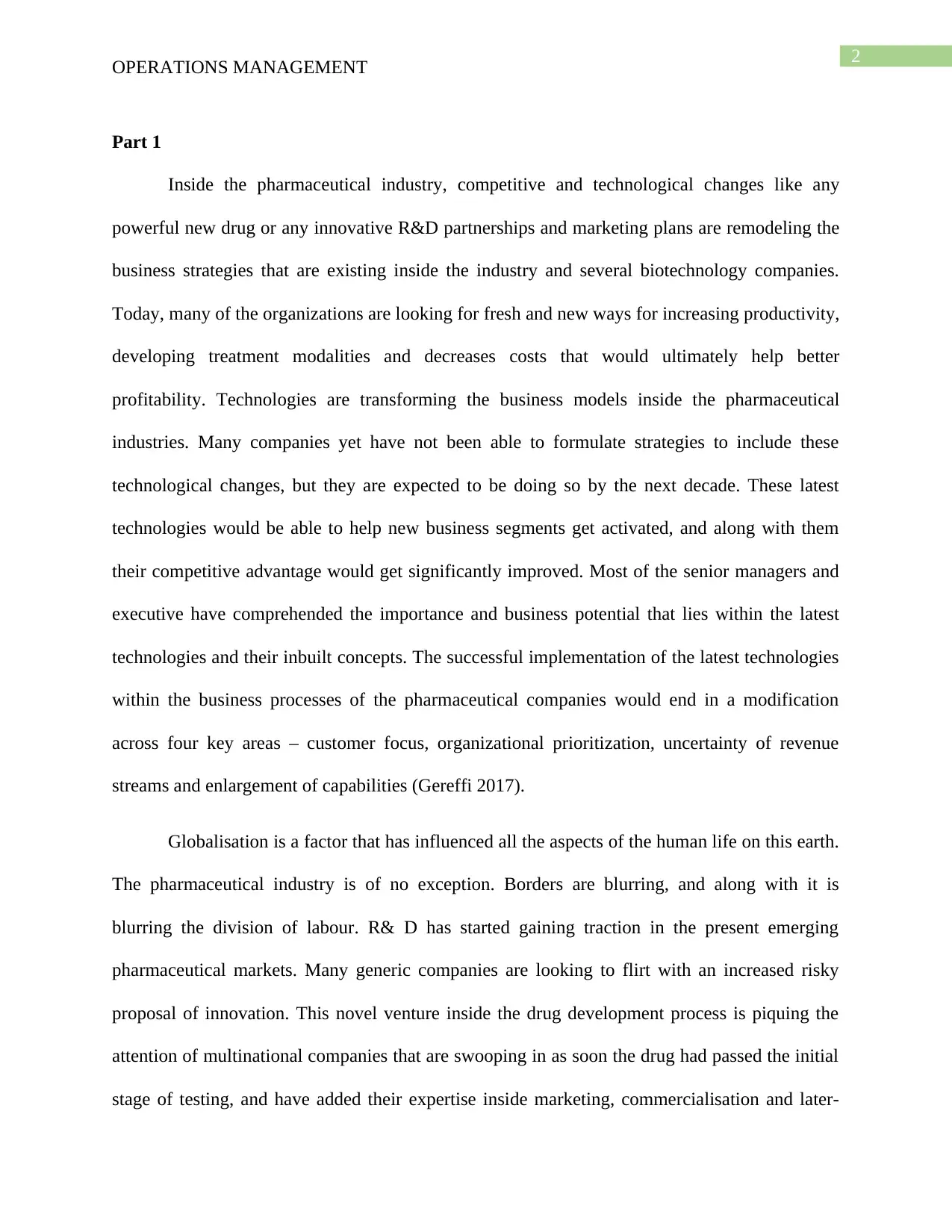
2
OPERATIONS MANAGEMENT
Part 1
Inside the pharmaceutical industry, competitive and technological changes like any
powerful new drug or any innovative R&D partnerships and marketing plans are remodeling the
business strategies that are existing inside the industry and several biotechnology companies.
Today, many of the organizations are looking for fresh and new ways for increasing productivity,
developing treatment modalities and decreases costs that would ultimately help better
profitability. Technologies are transforming the business models inside the pharmaceutical
industries. Many companies yet have not been able to formulate strategies to include these
technological changes, but they are expected to be doing so by the next decade. These latest
technologies would be able to help new business segments get activated, and along with them
their competitive advantage would get significantly improved. Most of the senior managers and
executive have comprehended the importance and business potential that lies within the latest
technologies and their inbuilt concepts. The successful implementation of the latest technologies
within the business processes of the pharmaceutical companies would end in a modification
across four key areas – customer focus, organizational prioritization, uncertainty of revenue
streams and enlargement of capabilities (Gereffi 2017).
Globalisation is a factor that has influenced all the aspects of the human life on this earth.
The pharmaceutical industry is of no exception. Borders are blurring, and along with it is
blurring the division of labour. R& D has started gaining traction in the present emerging
pharmaceutical markets. Many generic companies are looking to flirt with an increased risky
proposal of innovation. This novel venture inside the drug development process is piquing the
attention of multinational companies that are swooping in as soon the drug had passed the initial
stage of testing, and have added their expertise inside marketing, commercialisation and later-
OPERATIONS MANAGEMENT
Part 1
Inside the pharmaceutical industry, competitive and technological changes like any
powerful new drug or any innovative R&D partnerships and marketing plans are remodeling the
business strategies that are existing inside the industry and several biotechnology companies.
Today, many of the organizations are looking for fresh and new ways for increasing productivity,
developing treatment modalities and decreases costs that would ultimately help better
profitability. Technologies are transforming the business models inside the pharmaceutical
industries. Many companies yet have not been able to formulate strategies to include these
technological changes, but they are expected to be doing so by the next decade. These latest
technologies would be able to help new business segments get activated, and along with them
their competitive advantage would get significantly improved. Most of the senior managers and
executive have comprehended the importance and business potential that lies within the latest
technologies and their inbuilt concepts. The successful implementation of the latest technologies
within the business processes of the pharmaceutical companies would end in a modification
across four key areas – customer focus, organizational prioritization, uncertainty of revenue
streams and enlargement of capabilities (Gereffi 2017).
Globalisation is a factor that has influenced all the aspects of the human life on this earth.
The pharmaceutical industry is of no exception. Borders are blurring, and along with it is
blurring the division of labour. R& D has started gaining traction in the present emerging
pharmaceutical markets. Many generic companies are looking to flirt with an increased risky
proposal of innovation. This novel venture inside the drug development process is piquing the
attention of multinational companies that are swooping in as soon the drug had passed the initial
stage of testing, and have added their expertise inside marketing, commercialisation and later-
⊘ This is a preview!⊘
Do you want full access?
Subscribe today to unlock all pages.

Trusted by 1+ million students worldwide
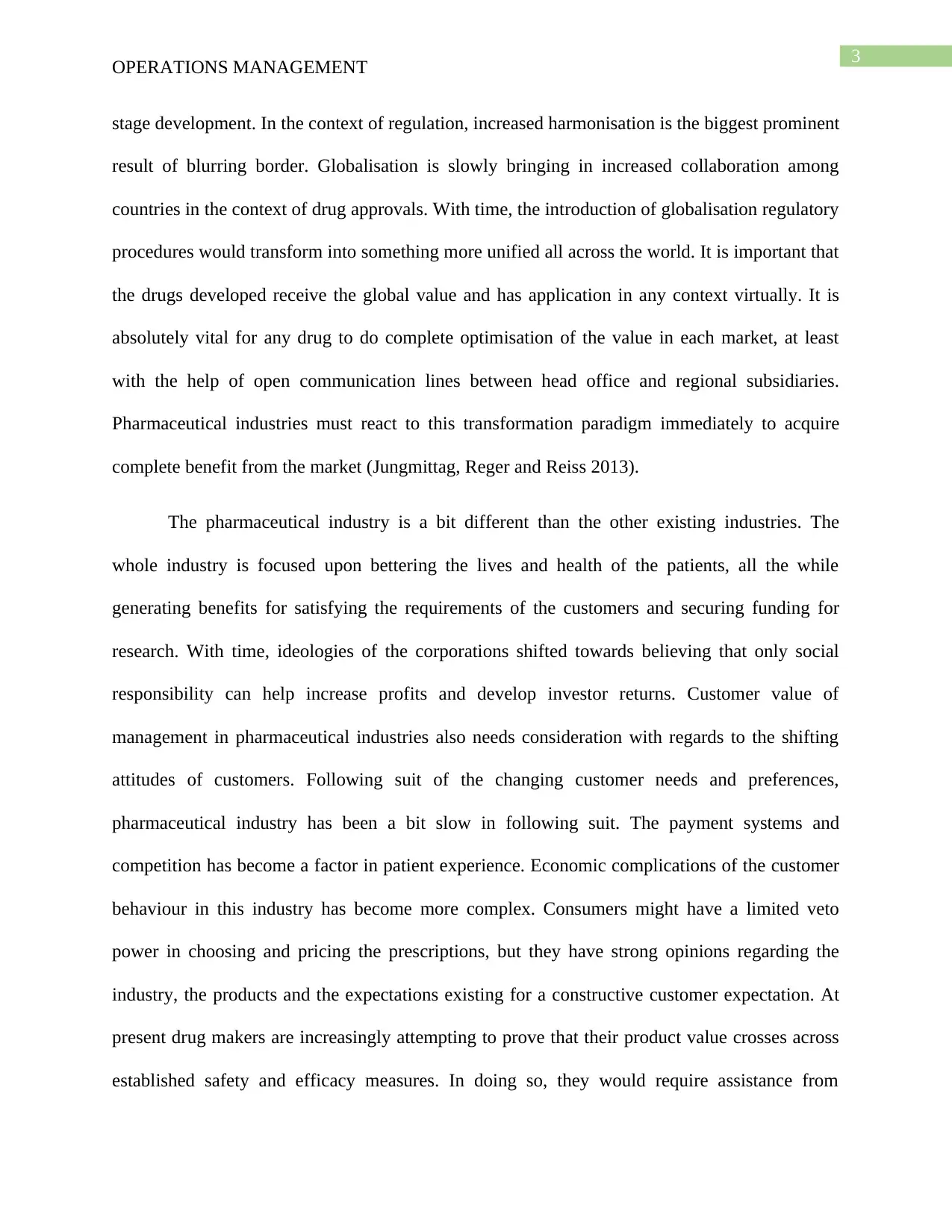
3
OPERATIONS MANAGEMENT
stage development. In the context of regulation, increased harmonisation is the biggest prominent
result of blurring border. Globalisation is slowly bringing in increased collaboration among
countries in the context of drug approvals. With time, the introduction of globalisation regulatory
procedures would transform into something more unified all across the world. It is important that
the drugs developed receive the global value and has application in any context virtually. It is
absolutely vital for any drug to do complete optimisation of the value in each market, at least
with the help of open communication lines between head office and regional subsidiaries.
Pharmaceutical industries must react to this transformation paradigm immediately to acquire
complete benefit from the market (Jungmittag, Reger and Reiss 2013).
The pharmaceutical industry is a bit different than the other existing industries. The
whole industry is focused upon bettering the lives and health of the patients, all the while
generating benefits for satisfying the requirements of the customers and securing funding for
research. With time, ideologies of the corporations shifted towards believing that only social
responsibility can help increase profits and develop investor returns. Customer value of
management in pharmaceutical industries also needs consideration with regards to the shifting
attitudes of customers. Following suit of the changing customer needs and preferences,
pharmaceutical industry has been a bit slow in following suit. The payment systems and
competition has become a factor in patient experience. Economic complications of the customer
behaviour in this industry has become more complex. Consumers might have a limited veto
power in choosing and pricing the prescriptions, but they have strong opinions regarding the
industry, the products and the expectations existing for a constructive customer expectation. At
present drug makers are increasingly attempting to prove that their product value crosses across
established safety and efficacy measures. In doing so, they would require assistance from
OPERATIONS MANAGEMENT
stage development. In the context of regulation, increased harmonisation is the biggest prominent
result of blurring border. Globalisation is slowly bringing in increased collaboration among
countries in the context of drug approvals. With time, the introduction of globalisation regulatory
procedures would transform into something more unified all across the world. It is important that
the drugs developed receive the global value and has application in any context virtually. It is
absolutely vital for any drug to do complete optimisation of the value in each market, at least
with the help of open communication lines between head office and regional subsidiaries.
Pharmaceutical industries must react to this transformation paradigm immediately to acquire
complete benefit from the market (Jungmittag, Reger and Reiss 2013).
The pharmaceutical industry is a bit different than the other existing industries. The
whole industry is focused upon bettering the lives and health of the patients, all the while
generating benefits for satisfying the requirements of the customers and securing funding for
research. With time, ideologies of the corporations shifted towards believing that only social
responsibility can help increase profits and develop investor returns. Customer value of
management in pharmaceutical industries also needs consideration with regards to the shifting
attitudes of customers. Following suit of the changing customer needs and preferences,
pharmaceutical industry has been a bit slow in following suit. The payment systems and
competition has become a factor in patient experience. Economic complications of the customer
behaviour in this industry has become more complex. Consumers might have a limited veto
power in choosing and pricing the prescriptions, but they have strong opinions regarding the
industry, the products and the expectations existing for a constructive customer expectation. At
present drug makers are increasingly attempting to prove that their product value crosses across
established safety and efficacy measures. In doing so, they would require assistance from
Paraphrase This Document
Need a fresh take? Get an instant paraphrase of this document with our AI Paraphraser
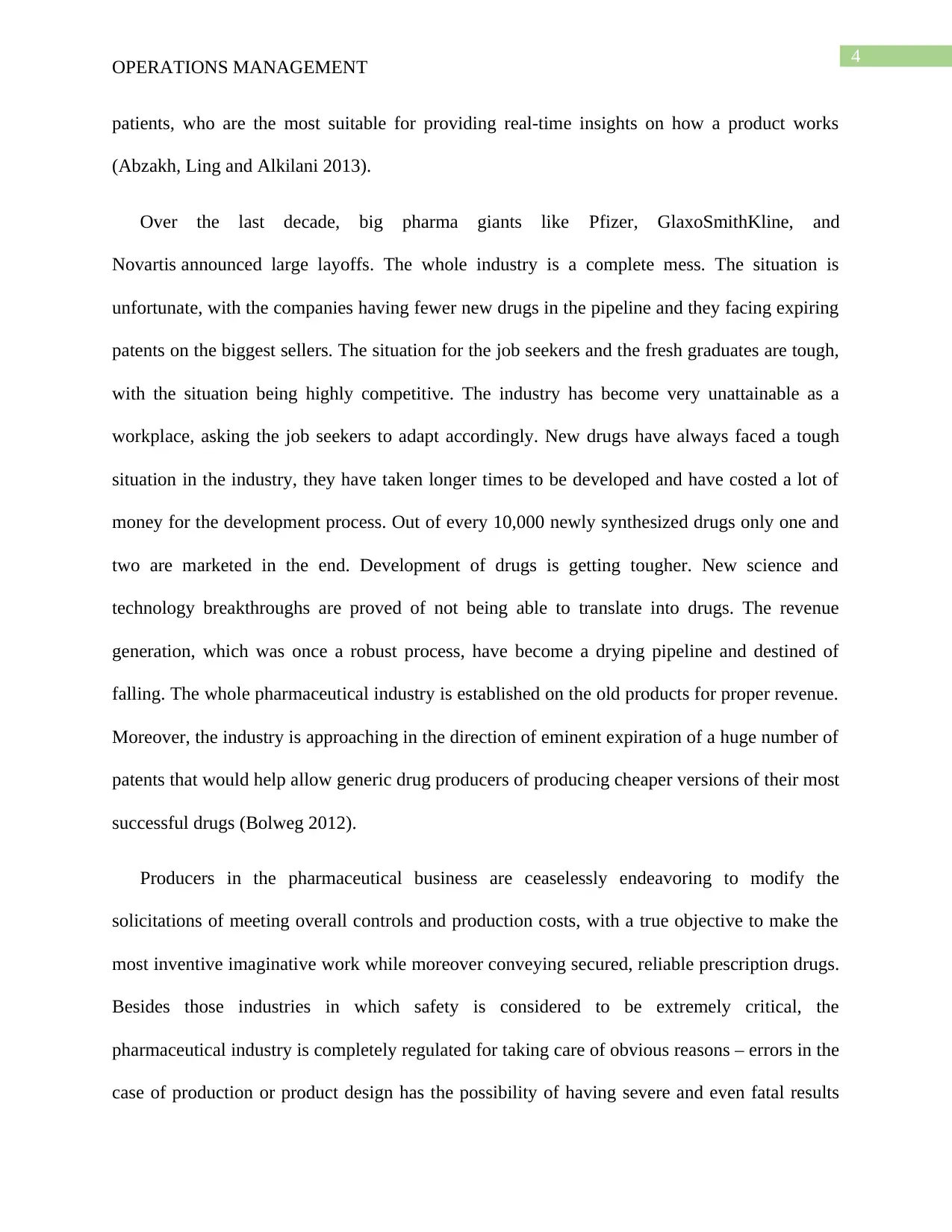
4
OPERATIONS MANAGEMENT
patients, who are the most suitable for providing real-time insights on how a product works
(Abzakh, Ling and Alkilani 2013).
Over the last decade, big pharma giants like Pfizer, GlaxoSmithKline, and
Novartis announced large layoffs. The whole industry is a complete mess. The situation is
unfortunate, with the companies having fewer new drugs in the pipeline and they facing expiring
patents on the biggest sellers. The situation for the job seekers and the fresh graduates are tough,
with the situation being highly competitive. The industry has become very unattainable as a
workplace, asking the job seekers to adapt accordingly. New drugs have always faced a tough
situation in the industry, they have taken longer times to be developed and have costed a lot of
money for the development process. Out of every 10,000 newly synthesized drugs only one and
two are marketed in the end. Development of drugs is getting tougher. New science and
technology breakthroughs are proved of not being able to translate into drugs. The revenue
generation, which was once a robust process, have become a drying pipeline and destined of
falling. The whole pharmaceutical industry is established on the old products for proper revenue.
Moreover, the industry is approaching in the direction of eminent expiration of a huge number of
patents that would help allow generic drug producers of producing cheaper versions of their most
successful drugs (Bolweg 2012).
Producers in the pharmaceutical business are ceaselessly endeavoring to modify the
solicitations of meeting overall controls and production costs, with a true objective to make the
most inventive imaginative work while moreover conveying secured, reliable prescription drugs.
Besides those industries in which safety is considered to be extremely critical, the
pharmaceutical industry is completely regulated for taking care of obvious reasons – errors in the
case of production or product design has the possibility of having severe and even fatal results
OPERATIONS MANAGEMENT
patients, who are the most suitable for providing real-time insights on how a product works
(Abzakh, Ling and Alkilani 2013).
Over the last decade, big pharma giants like Pfizer, GlaxoSmithKline, and
Novartis announced large layoffs. The whole industry is a complete mess. The situation is
unfortunate, with the companies having fewer new drugs in the pipeline and they facing expiring
patents on the biggest sellers. The situation for the job seekers and the fresh graduates are tough,
with the situation being highly competitive. The industry has become very unattainable as a
workplace, asking the job seekers to adapt accordingly. New drugs have always faced a tough
situation in the industry, they have taken longer times to be developed and have costed a lot of
money for the development process. Out of every 10,000 newly synthesized drugs only one and
two are marketed in the end. Development of drugs is getting tougher. New science and
technology breakthroughs are proved of not being able to translate into drugs. The revenue
generation, which was once a robust process, have become a drying pipeline and destined of
falling. The whole pharmaceutical industry is established on the old products for proper revenue.
Moreover, the industry is approaching in the direction of eminent expiration of a huge number of
patents that would help allow generic drug producers of producing cheaper versions of their most
successful drugs (Bolweg 2012).
Producers in the pharmaceutical business are ceaselessly endeavoring to modify the
solicitations of meeting overall controls and production costs, with a true objective to make the
most inventive imaginative work while moreover conveying secured, reliable prescription drugs.
Besides those industries in which safety is considered to be extremely critical, the
pharmaceutical industry is completely regulated for taking care of obvious reasons – errors in the
case of production or product design has the possibility of having severe and even fatal results
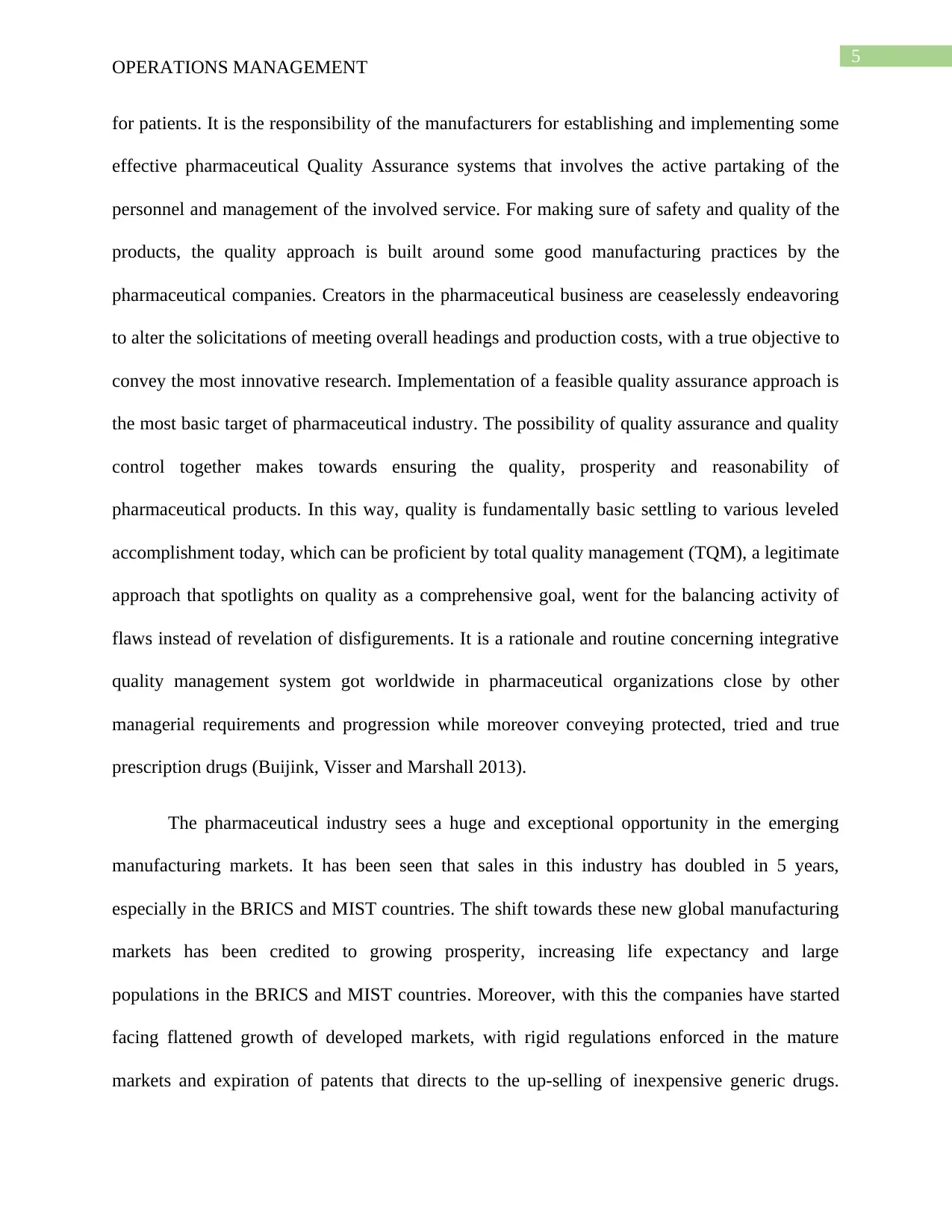
5
OPERATIONS MANAGEMENT
for patients. It is the responsibility of the manufacturers for establishing and implementing some
effective pharmaceutical Quality Assurance systems that involves the active partaking of the
personnel and management of the involved service. For making sure of safety and quality of the
products, the quality approach is built around some good manufacturing practices by the
pharmaceutical companies. Creators in the pharmaceutical business are ceaselessly endeavoring
to alter the solicitations of meeting overall headings and production costs, with a true objective to
convey the most innovative research. Implementation of a feasible quality assurance approach is
the most basic target of pharmaceutical industry. The possibility of quality assurance and quality
control together makes towards ensuring the quality, prosperity and reasonability of
pharmaceutical products. In this way, quality is fundamentally basic settling to various leveled
accomplishment today, which can be proficient by total quality management (TQM), a legitimate
approach that spotlights on quality as a comprehensive goal, went for the balancing activity of
flaws instead of revelation of disfigurements. It is a rationale and routine concerning integrative
quality management system got worldwide in pharmaceutical organizations close by other
managerial requirements and progression while moreover conveying protected, tried and true
prescription drugs (Buijink, Visser and Marshall 2013).
The pharmaceutical industry sees a huge and exceptional opportunity in the emerging
manufacturing markets. It has been seen that sales in this industry has doubled in 5 years,
especially in the BRICS and MIST countries. The shift towards these new global manufacturing
markets has been credited to growing prosperity, increasing life expectancy and large
populations in the BRICS and MIST countries. Moreover, with this the companies have started
facing flattened growth of developed markets, with rigid regulations enforced in the mature
markets and expiration of patents that directs to the up-selling of inexpensive generic drugs.
OPERATIONS MANAGEMENT
for patients. It is the responsibility of the manufacturers for establishing and implementing some
effective pharmaceutical Quality Assurance systems that involves the active partaking of the
personnel and management of the involved service. For making sure of safety and quality of the
products, the quality approach is built around some good manufacturing practices by the
pharmaceutical companies. Creators in the pharmaceutical business are ceaselessly endeavoring
to alter the solicitations of meeting overall headings and production costs, with a true objective to
convey the most innovative research. Implementation of a feasible quality assurance approach is
the most basic target of pharmaceutical industry. The possibility of quality assurance and quality
control together makes towards ensuring the quality, prosperity and reasonability of
pharmaceutical products. In this way, quality is fundamentally basic settling to various leveled
accomplishment today, which can be proficient by total quality management (TQM), a legitimate
approach that spotlights on quality as a comprehensive goal, went for the balancing activity of
flaws instead of revelation of disfigurements. It is a rationale and routine concerning integrative
quality management system got worldwide in pharmaceutical organizations close by other
managerial requirements and progression while moreover conveying protected, tried and true
prescription drugs (Buijink, Visser and Marshall 2013).
The pharmaceutical industry sees a huge and exceptional opportunity in the emerging
manufacturing markets. It has been seen that sales in this industry has doubled in 5 years,
especially in the BRICS and MIST countries. The shift towards these new global manufacturing
markets has been credited to growing prosperity, increasing life expectancy and large
populations in the BRICS and MIST countries. Moreover, with this the companies have started
facing flattened growth of developed markets, with rigid regulations enforced in the mature
markets and expiration of patents that directs to the up-selling of inexpensive generic drugs.
⊘ This is a preview!⊘
Do you want full access?
Subscribe today to unlock all pages.

Trusted by 1+ million students worldwide
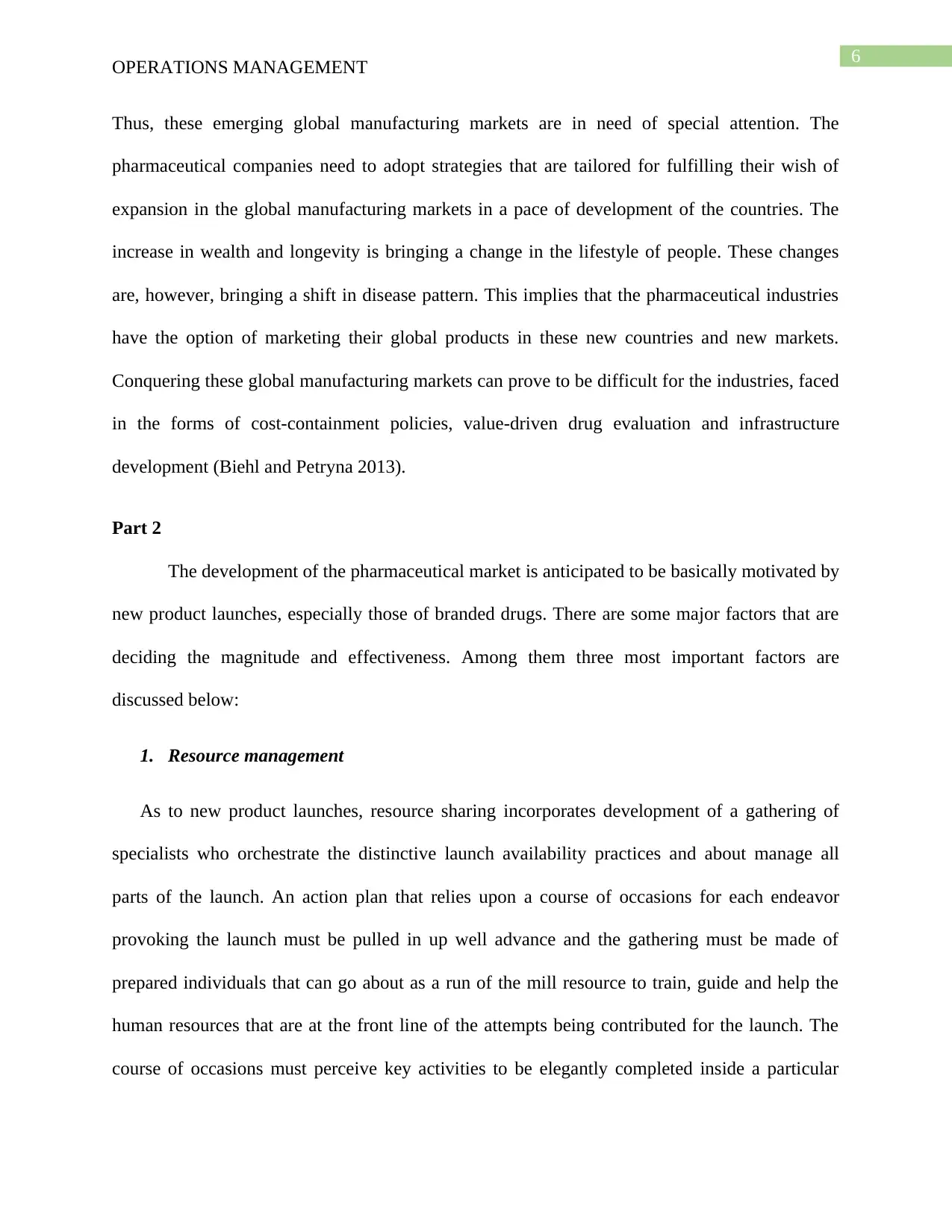
6
OPERATIONS MANAGEMENT
Thus, these emerging global manufacturing markets are in need of special attention. The
pharmaceutical companies need to adopt strategies that are tailored for fulfilling their wish of
expansion in the global manufacturing markets in a pace of development of the countries. The
increase in wealth and longevity is bringing a change in the lifestyle of people. These changes
are, however, bringing a shift in disease pattern. This implies that the pharmaceutical industries
have the option of marketing their global products in these new countries and new markets.
Conquering these global manufacturing markets can prove to be difficult for the industries, faced
in the forms of cost-containment policies, value-driven drug evaluation and infrastructure
development (Biehl and Petryna 2013).
Part 2
The development of the pharmaceutical market is anticipated to be basically motivated by
new product launches, especially those of branded drugs. There are some major factors that are
deciding the magnitude and effectiveness. Among them three most important factors are
discussed below:
1. Resource management
As to new product launches, resource sharing incorporates development of a gathering of
specialists who orchestrate the distinctive launch availability practices and about manage all
parts of the launch. An action plan that relies upon a course of occasions for each endeavor
provoking the launch must be pulled in up well advance and the gathering must be made of
prepared individuals that can go about as a run of the mill resource to train, guide and help the
human resources that are at the front line of the attempts being contributed for the launch. The
course of occasions must perceive key activities to be elegantly completed inside a particular
OPERATIONS MANAGEMENT
Thus, these emerging global manufacturing markets are in need of special attention. The
pharmaceutical companies need to adopt strategies that are tailored for fulfilling their wish of
expansion in the global manufacturing markets in a pace of development of the countries. The
increase in wealth and longevity is bringing a change in the lifestyle of people. These changes
are, however, bringing a shift in disease pattern. This implies that the pharmaceutical industries
have the option of marketing their global products in these new countries and new markets.
Conquering these global manufacturing markets can prove to be difficult for the industries, faced
in the forms of cost-containment policies, value-driven drug evaluation and infrastructure
development (Biehl and Petryna 2013).
Part 2
The development of the pharmaceutical market is anticipated to be basically motivated by
new product launches, especially those of branded drugs. There are some major factors that are
deciding the magnitude and effectiveness. Among them three most important factors are
discussed below:
1. Resource management
As to new product launches, resource sharing incorporates development of a gathering of
specialists who orchestrate the distinctive launch availability practices and about manage all
parts of the launch. An action plan that relies upon a course of occasions for each endeavor
provoking the launch must be pulled in up well advance and the gathering must be made of
prepared individuals that can go about as a run of the mill resource to train, guide and help the
human resources that are at the front line of the attempts being contributed for the launch. The
course of occasions must perceive key activities to be elegantly completed inside a particular
Paraphrase This Document
Need a fresh take? Get an instant paraphrase of this document with our AI Paraphraser
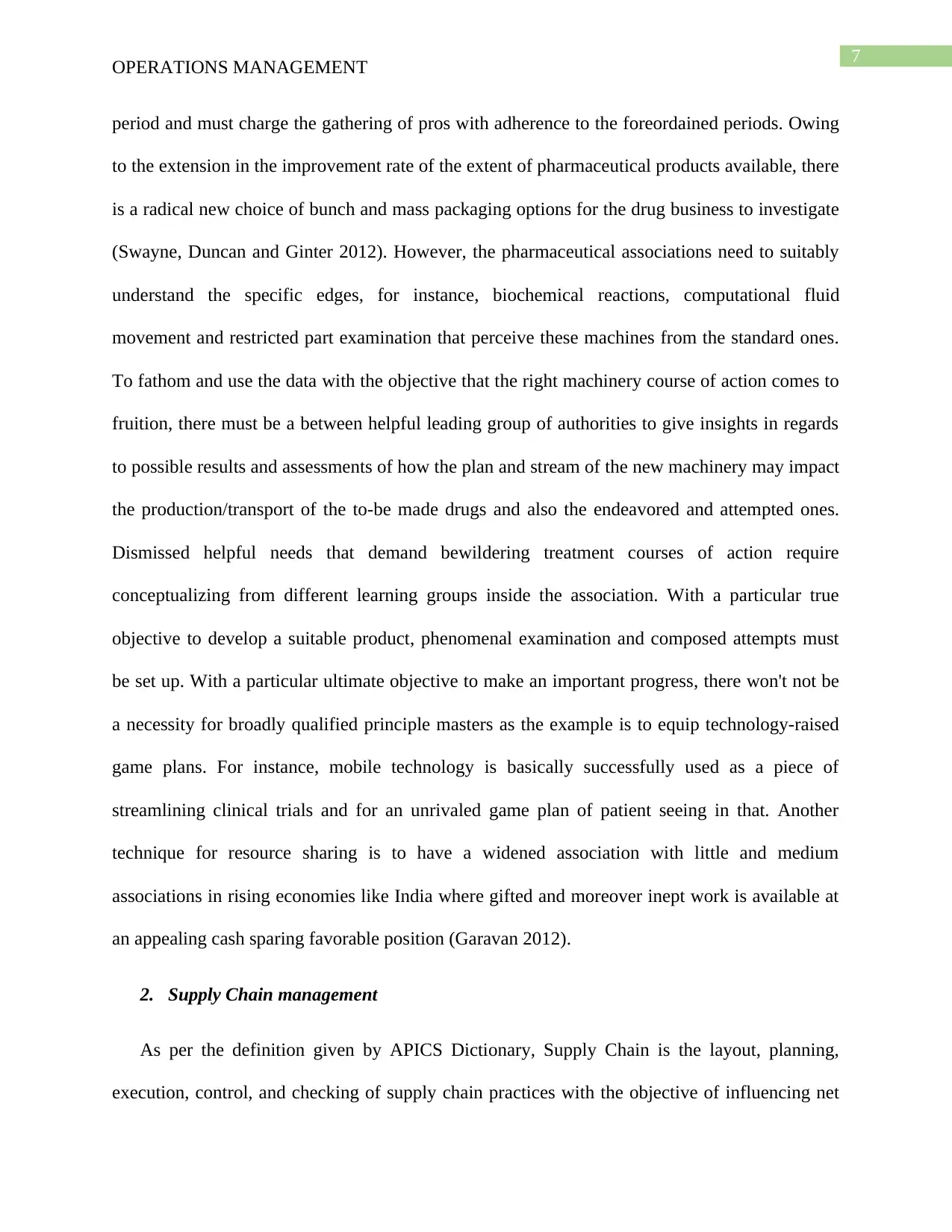
7
OPERATIONS MANAGEMENT
period and must charge the gathering of pros with adherence to the foreordained periods. Owing
to the extension in the improvement rate of the extent of pharmaceutical products available, there
is a radical new choice of bunch and mass packaging options for the drug business to investigate
(Swayne, Duncan and Ginter 2012). However, the pharmaceutical associations need to suitably
understand the specific edges, for instance, biochemical reactions, computational fluid
movement and restricted part examination that perceive these machines from the standard ones.
To fathom and use the data with the objective that the right machinery course of action comes to
fruition, there must be a between helpful leading group of authorities to give insights in regards
to possible results and assessments of how the plan and stream of the new machinery may impact
the production/transport of the to-be made drugs and also the endeavored and attempted ones.
Dismissed helpful needs that demand bewildering treatment courses of action require
conceptualizing from different learning groups inside the association. With a particular true
objective to develop a suitable product, phenomenal examination and composed attempts must
be set up. With a particular ultimate objective to make an important progress, there won't not be
a necessity for broadly qualified principle masters as the example is to equip technology-raised
game plans. For instance, mobile technology is basically successfully used as a piece of
streamlining clinical trials and for an unrivaled game plan of patient seeing in that. Another
technique for resource sharing is to have a widened association with little and medium
associations in rising economies like India where gifted and moreover inept work is available at
an appealing cash sparing favorable position (Garavan 2012).
2. Supply Chain management
As per the definition given by APICS Dictionary, Supply Chain is the layout, planning,
execution, control, and checking of supply chain practices with the objective of influencing net
OPERATIONS MANAGEMENT
period and must charge the gathering of pros with adherence to the foreordained periods. Owing
to the extension in the improvement rate of the extent of pharmaceutical products available, there
is a radical new choice of bunch and mass packaging options for the drug business to investigate
(Swayne, Duncan and Ginter 2012). However, the pharmaceutical associations need to suitably
understand the specific edges, for instance, biochemical reactions, computational fluid
movement and restricted part examination that perceive these machines from the standard ones.
To fathom and use the data with the objective that the right machinery course of action comes to
fruition, there must be a between helpful leading group of authorities to give insights in regards
to possible results and assessments of how the plan and stream of the new machinery may impact
the production/transport of the to-be made drugs and also the endeavored and attempted ones.
Dismissed helpful needs that demand bewildering treatment courses of action require
conceptualizing from different learning groups inside the association. With a particular true
objective to develop a suitable product, phenomenal examination and composed attempts must
be set up. With a particular ultimate objective to make an important progress, there won't not be
a necessity for broadly qualified principle masters as the example is to equip technology-raised
game plans. For instance, mobile technology is basically successfully used as a piece of
streamlining clinical trials and for an unrivaled game plan of patient seeing in that. Another
technique for resource sharing is to have a widened association with little and medium
associations in rising economies like India where gifted and moreover inept work is available at
an appealing cash sparing favorable position (Garavan 2012).
2. Supply Chain management
As per the definition given by APICS Dictionary, Supply Chain is the layout, planning,
execution, control, and checking of supply chain practices with the objective of influencing net
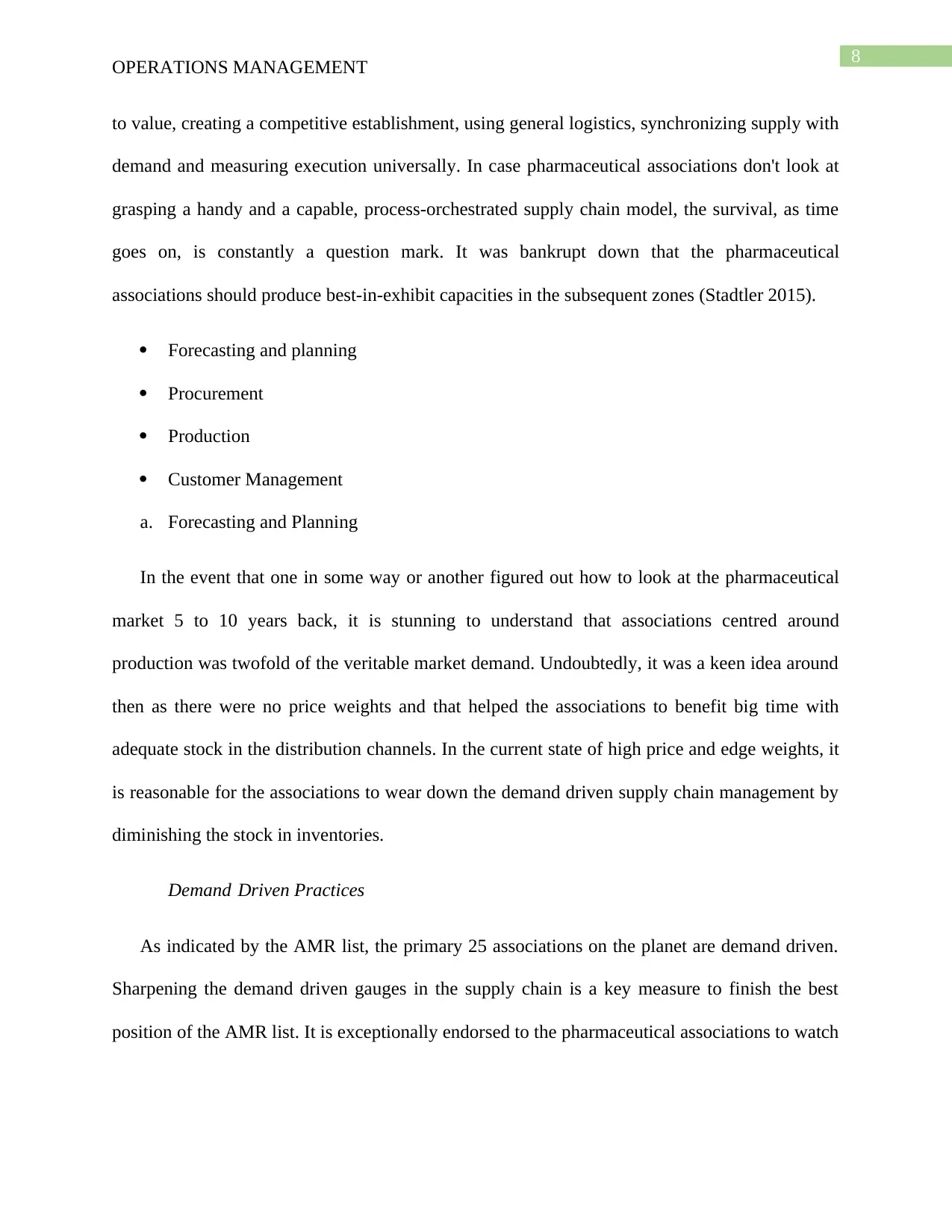
8
OPERATIONS MANAGEMENT
to value, creating a competitive establishment, using general logistics, synchronizing supply with
demand and measuring execution universally. In case pharmaceutical associations don't look at
grasping a handy and a capable, process-orchestrated supply chain model, the survival, as time
goes on, is constantly a question mark. It was bankrupt down that the pharmaceutical
associations should produce best-in-exhibit capacities in the subsequent zones (Stadtler 2015).
Forecasting and planning
Procurement
Production
Customer Management
a. Forecasting and Planning
In the event that one in some way or another figured out how to look at the pharmaceutical
market 5 to 10 years back, it is stunning to understand that associations centred around
production was twofold of the veritable market demand. Undoubtedly, it was a keen idea around
then as there were no price weights and that helped the associations to benefit big time with
adequate stock in the distribution channels. In the current state of high price and edge weights, it
is reasonable for the associations to wear down the demand driven supply chain management by
diminishing the stock in inventories.
Demand Driven Practices
As indicated by the AMR list, the primary 25 associations on the planet are demand driven.
Sharpening the demand driven gauges in the supply chain is a key measure to finish the best
position of the AMR list. It is exceptionally endorsed to the pharmaceutical associations to watch
OPERATIONS MANAGEMENT
to value, creating a competitive establishment, using general logistics, synchronizing supply with
demand and measuring execution universally. In case pharmaceutical associations don't look at
grasping a handy and a capable, process-orchestrated supply chain model, the survival, as time
goes on, is constantly a question mark. It was bankrupt down that the pharmaceutical
associations should produce best-in-exhibit capacities in the subsequent zones (Stadtler 2015).
Forecasting and planning
Procurement
Production
Customer Management
a. Forecasting and Planning
In the event that one in some way or another figured out how to look at the pharmaceutical
market 5 to 10 years back, it is stunning to understand that associations centred around
production was twofold of the veritable market demand. Undoubtedly, it was a keen idea around
then as there were no price weights and that helped the associations to benefit big time with
adequate stock in the distribution channels. In the current state of high price and edge weights, it
is reasonable for the associations to wear down the demand driven supply chain management by
diminishing the stock in inventories.
Demand Driven Practices
As indicated by the AMR list, the primary 25 associations on the planet are demand driven.
Sharpening the demand driven gauges in the supply chain is a key measure to finish the best
position of the AMR list. It is exceptionally endorsed to the pharmaceutical associations to watch
⊘ This is a preview!⊘
Do you want full access?
Subscribe today to unlock all pages.

Trusted by 1+ million students worldwide
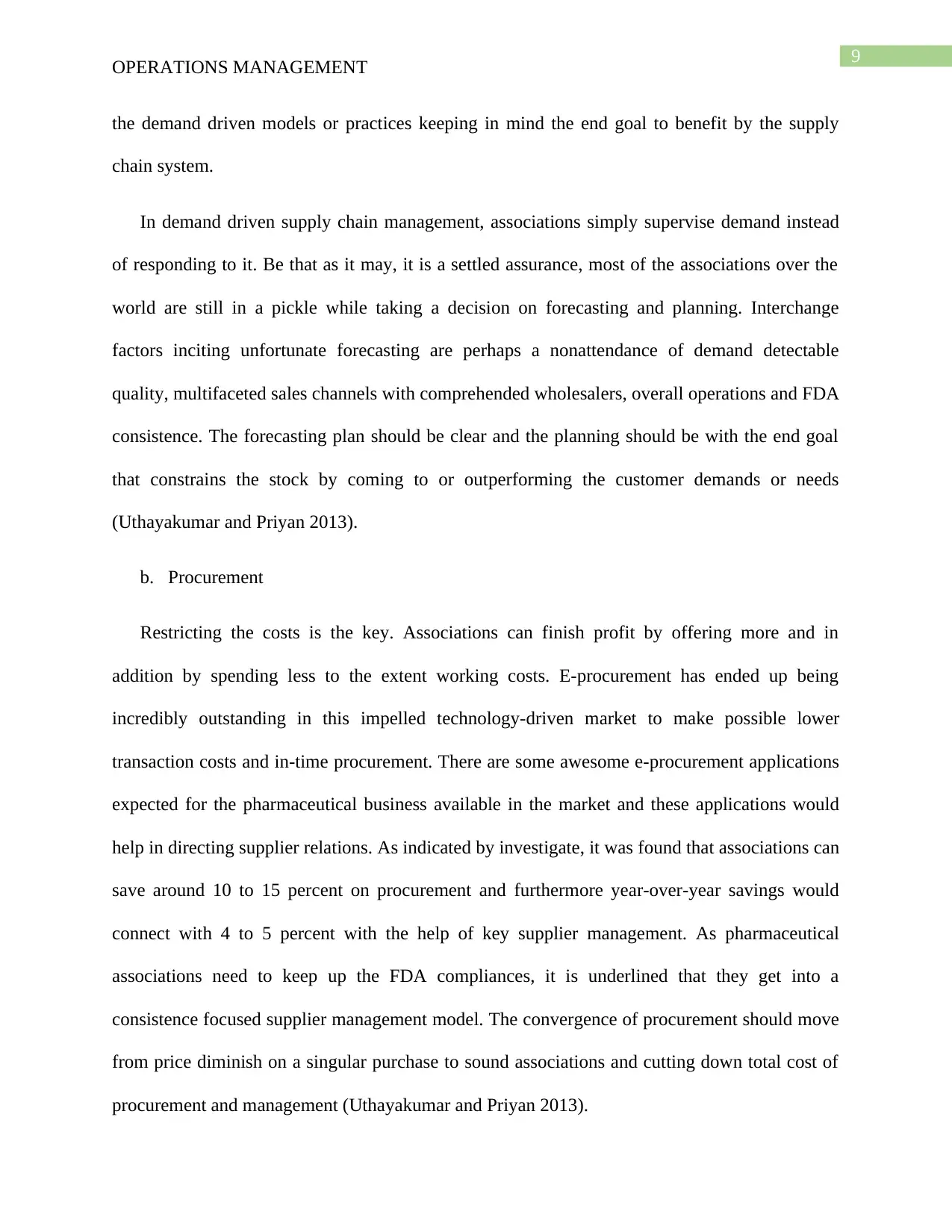
9
OPERATIONS MANAGEMENT
the demand driven models or practices keeping in mind the end goal to benefit by the supply
chain system.
In demand driven supply chain management, associations simply supervise demand instead
of responding to it. Be that as it may, it is a settled assurance, most of the associations over the
world are still in a pickle while taking a decision on forecasting and planning. Interchange
factors inciting unfortunate forecasting are perhaps a nonattendance of demand detectable
quality, multifaceted sales channels with comprehended wholesalers, overall operations and FDA
consistence. The forecasting plan should be clear and the planning should be with the end goal
that constrains the stock by coming to or outperforming the customer demands or needs
(Uthayakumar and Priyan 2013).
b. Procurement
Restricting the costs is the key. Associations can finish profit by offering more and in
addition by spending less to the extent working costs. E-procurement has ended up being
incredibly outstanding in this impelled technology-driven market to make possible lower
transaction costs and in-time procurement. There are some awesome e-procurement applications
expected for the pharmaceutical business available in the market and these applications would
help in directing supplier relations. As indicated by investigate, it was found that associations can
save around 10 to 15 percent on procurement and furthermore year-over-year savings would
connect with 4 to 5 percent with the help of key supplier management. As pharmaceutical
associations need to keep up the FDA compliances, it is underlined that they get into a
consistence focused supplier management model. The convergence of procurement should move
from price diminish on a singular purchase to sound associations and cutting down total cost of
procurement and management (Uthayakumar and Priyan 2013).
OPERATIONS MANAGEMENT
the demand driven models or practices keeping in mind the end goal to benefit by the supply
chain system.
In demand driven supply chain management, associations simply supervise demand instead
of responding to it. Be that as it may, it is a settled assurance, most of the associations over the
world are still in a pickle while taking a decision on forecasting and planning. Interchange
factors inciting unfortunate forecasting are perhaps a nonattendance of demand detectable
quality, multifaceted sales channels with comprehended wholesalers, overall operations and FDA
consistence. The forecasting plan should be clear and the planning should be with the end goal
that constrains the stock by coming to or outperforming the customer demands or needs
(Uthayakumar and Priyan 2013).
b. Procurement
Restricting the costs is the key. Associations can finish profit by offering more and in
addition by spending less to the extent working costs. E-procurement has ended up being
incredibly outstanding in this impelled technology-driven market to make possible lower
transaction costs and in-time procurement. There are some awesome e-procurement applications
expected for the pharmaceutical business available in the market and these applications would
help in directing supplier relations. As indicated by investigate, it was found that associations can
save around 10 to 15 percent on procurement and furthermore year-over-year savings would
connect with 4 to 5 percent with the help of key supplier management. As pharmaceutical
associations need to keep up the FDA compliances, it is underlined that they get into a
consistence focused supplier management model. The convergence of procurement should move
from price diminish on a singular purchase to sound associations and cutting down total cost of
procurement and management (Uthayakumar and Priyan 2013).
Paraphrase This Document
Need a fresh take? Get an instant paraphrase of this document with our AI Paraphraser
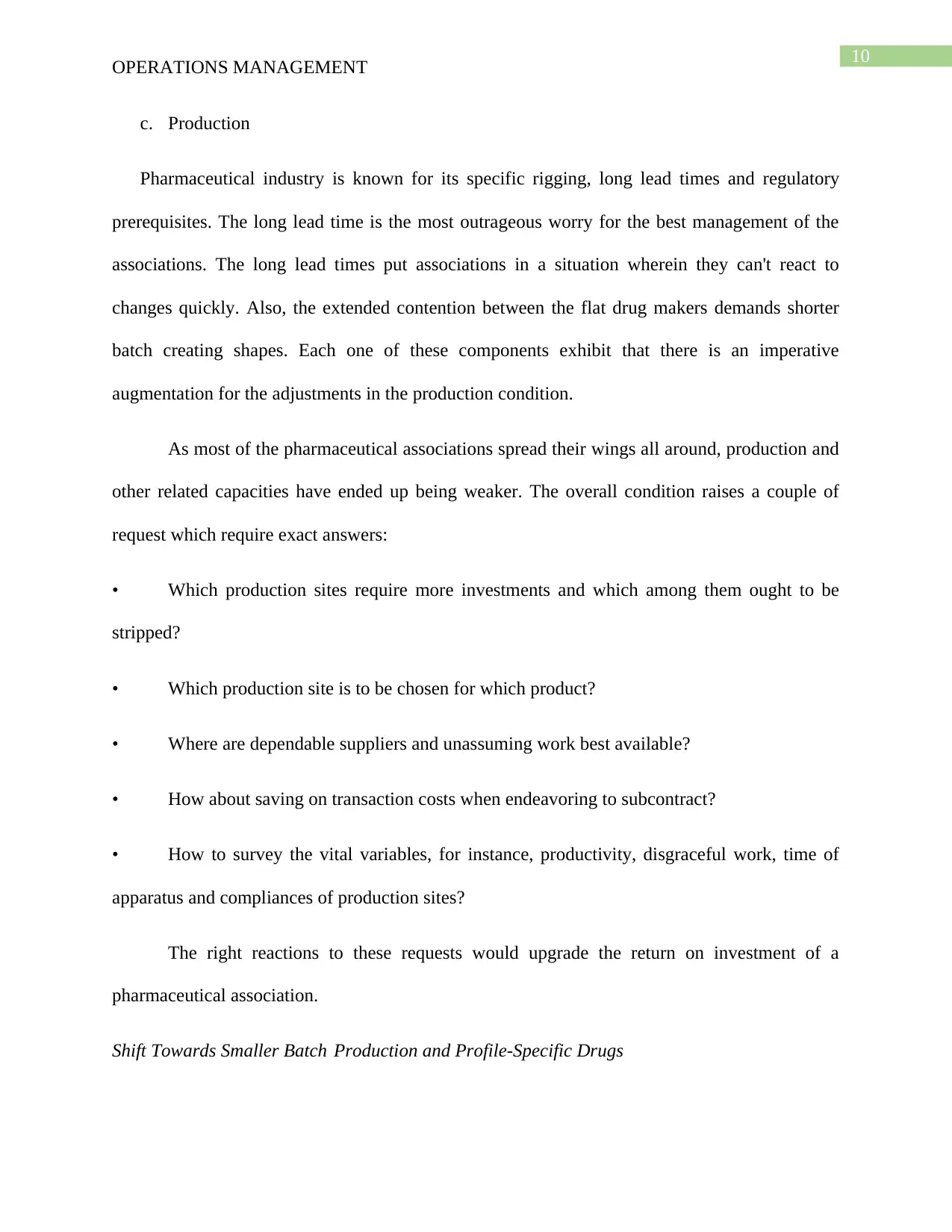
10
OPERATIONS MANAGEMENT
c. Production
Pharmaceutical industry is known for its specific rigging, long lead times and regulatory
prerequisites. The long lead time is the most outrageous worry for the best management of the
associations. The long lead times put associations in a situation wherein they can't react to
changes quickly. Also, the extended contention between the flat drug makers demands shorter
batch creating shapes. Each one of these components exhibit that there is an imperative
augmentation for the adjustments in the production condition.
As most of the pharmaceutical associations spread their wings all around, production and
other related capacities have ended up being weaker. The overall condition raises a couple of
request which require exact answers:
• Which production sites require more investments and which among them ought to be
stripped?
• Which production site is to be chosen for which product?
• Where are dependable suppliers and unassuming work best available?
• How about saving on transaction costs when endeavoring to subcontract?
• How to survey the vital variables, for instance, productivity, disgraceful work, time of
apparatus and compliances of production sites?
The right reactions to these requests would upgrade the return on investment of a
pharmaceutical association.
Shift Towards Smaller Batch Production and Profile-Specific Drugs
OPERATIONS MANAGEMENT
c. Production
Pharmaceutical industry is known for its specific rigging, long lead times and regulatory
prerequisites. The long lead time is the most outrageous worry for the best management of the
associations. The long lead times put associations in a situation wherein they can't react to
changes quickly. Also, the extended contention between the flat drug makers demands shorter
batch creating shapes. Each one of these components exhibit that there is an imperative
augmentation for the adjustments in the production condition.
As most of the pharmaceutical associations spread their wings all around, production and
other related capacities have ended up being weaker. The overall condition raises a couple of
request which require exact answers:
• Which production sites require more investments and which among them ought to be
stripped?
• Which production site is to be chosen for which product?
• Where are dependable suppliers and unassuming work best available?
• How about saving on transaction costs when endeavoring to subcontract?
• How to survey the vital variables, for instance, productivity, disgraceful work, time of
apparatus and compliances of production sites?
The right reactions to these requests would upgrade the return on investment of a
pharmaceutical association.
Shift Towards Smaller Batch Production and Profile-Specific Drugs
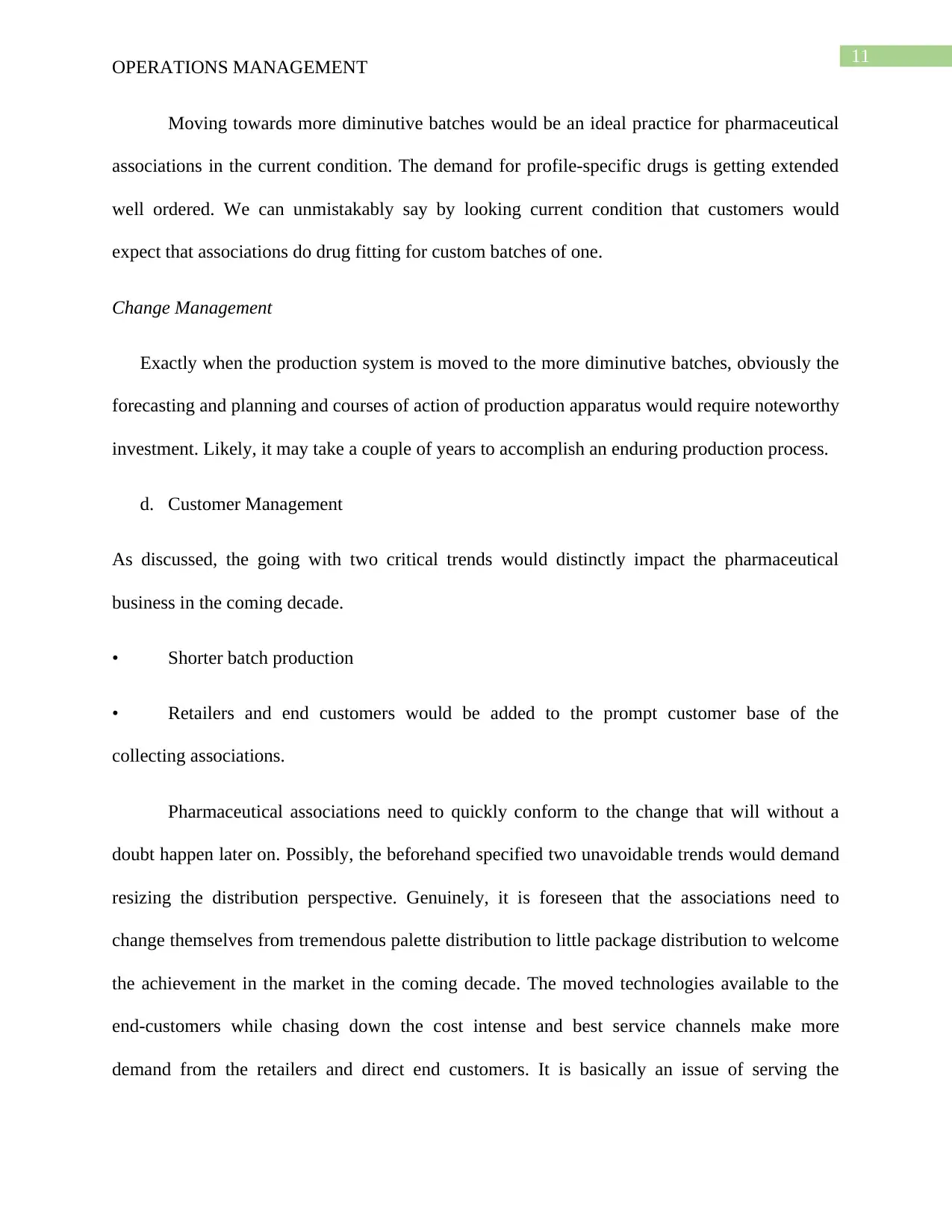
11
OPERATIONS MANAGEMENT
Moving towards more diminutive batches would be an ideal practice for pharmaceutical
associations in the current condition. The demand for profile-specific drugs is getting extended
well ordered. We can unmistakably say by looking current condition that customers would
expect that associations do drug fitting for custom batches of one.
Change Management
Exactly when the production system is moved to the more diminutive batches, obviously the
forecasting and planning and courses of action of production apparatus would require noteworthy
investment. Likely, it may take a couple of years to accomplish an enduring production process.
d. Customer Management
As discussed, the going with two critical trends would distinctly impact the pharmaceutical
business in the coming decade.
• Shorter batch production
• Retailers and end customers would be added to the prompt customer base of the
collecting associations.
Pharmaceutical associations need to quickly conform to the change that will without a
doubt happen later on. Possibly, the beforehand specified two unavoidable trends would demand
resizing the distribution perspective. Genuinely, it is foreseen that the associations need to
change themselves from tremendous palette distribution to little package distribution to welcome
the achievement in the market in the coming decade. The moved technologies available to the
end-customers while chasing down the cost intense and best service channels make more
demand from the retailers and direct end customers. It is basically an issue of serving the
OPERATIONS MANAGEMENT
Moving towards more diminutive batches would be an ideal practice for pharmaceutical
associations in the current condition. The demand for profile-specific drugs is getting extended
well ordered. We can unmistakably say by looking current condition that customers would
expect that associations do drug fitting for custom batches of one.
Change Management
Exactly when the production system is moved to the more diminutive batches, obviously the
forecasting and planning and courses of action of production apparatus would require noteworthy
investment. Likely, it may take a couple of years to accomplish an enduring production process.
d. Customer Management
As discussed, the going with two critical trends would distinctly impact the pharmaceutical
business in the coming decade.
• Shorter batch production
• Retailers and end customers would be added to the prompt customer base of the
collecting associations.
Pharmaceutical associations need to quickly conform to the change that will without a
doubt happen later on. Possibly, the beforehand specified two unavoidable trends would demand
resizing the distribution perspective. Genuinely, it is foreseen that the associations need to
change themselves from tremendous palette distribution to little package distribution to welcome
the achievement in the market in the coming decade. The moved technologies available to the
end-customers while chasing down the cost intense and best service channels make more
demand from the retailers and direct end customers. It is basically an issue of serving the
⊘ This is a preview!⊘
Do you want full access?
Subscribe today to unlock all pages.

Trusted by 1+ million students worldwide
1 out of 16
Related Documents
Your All-in-One AI-Powered Toolkit for Academic Success.
+13062052269
info@desklib.com
Available 24*7 on WhatsApp / Email
![[object Object]](/_next/static/media/star-bottom.7253800d.svg)
Unlock your academic potential
Copyright © 2020–2025 A2Z Services. All Rights Reserved. Developed and managed by ZUCOL.





